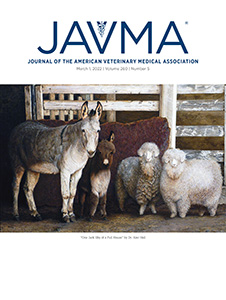- March 8, 2022
- No Comment
- 4 minutes read
Effects of diet restriction on life span and age-related changes in dogs – American Veterinary Medical Association

Advertisement
.avma_container { background: #ddd; width: 100%; padding: 0; margin: 0; opacity: 1; display: flex; } .avma_container div{ display: flex; height: 10px; padding: 0; margin: 0; } .item01 { background: #EBF6F7; width: 100%; }
Advertisement
Objective—To evaluate the effects of 25% diet restriction on life span of dogs and on markers of aging.
Design—Paired feeding study.
Animals—48 Labrador Retrievers.
Procedures—Dogs were paired, and 1 dog in each pair was fed 25% less food than its pair-mate from 8 weeks of age until death. Serum biochemical analyses were performed, body condition was scored, and body composition was measured annually until 12 years of age. Age at onset of chronic disease and median (age when 50% of the dogs were deceased) and maximum (age when 90% of the dogs were deceased) life spans were evaluated.
Results—Compared with control dogs, food-restricted dogs weighed less and had lower body fat content and lower serum triglycerides, triiodothyronine, insulin, and glucose concentrations. Median life span was significantly longer for dogs in which food was restricted. The onset of clinical signs of chronic disease generally was delayed for food-restricted dogs.
Conclusions and Clinical Relevance—Results suggest that 25% restriction in food intake increased median life span and delayed the onset of signs of chronic disease in these dogs. (J Am Vet Med Assoc 2002;220:1315–1320)
Objective—To evaluate the effects of 25% diet restriction on life span of dogs and on markers of aging.
Design—Paired feeding study.
Animals—48 Labrador Retrievers.
Procedures—Dogs were paired, and 1 dog in each pair was fed 25% less food than its pair-mate from 8 weeks of age until death. Serum biochemical analyses were performed, body condition was scored, and body composition was measured annually until 12 years of age. Age at onset of chronic disease and median (age when 50% of the dogs were deceased) and maximum (age when 90% of the dogs were deceased) life spans were evaluated.
Results—Compared with control dogs, food-restricted dogs weighed less and had lower body fat content and lower serum triglycerides, triiodothyronine, insulin, and glucose concentrations. Median life span was significantly longer for dogs in which food was restricted. The onset of clinical signs of chronic disease generally was delayed for food-restricted dogs.
Conclusions and Clinical Relevance—Results suggest that 25% restriction in food intake increased median life span and delayed the onset of signs of chronic disease in these dogs. (J Am Vet Med Assoc 2002;220:1315–1320)
Follow the AVMA journals
Follow the AVMA
Subscribe to newsletters
© 2021 American Veterinary Medical Association. All rights reserved.
Powered by KGL PubFactory
Character limit 500/500
Character limit 500/500

